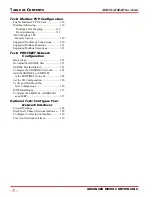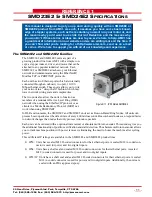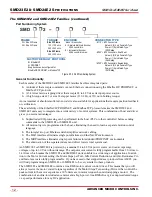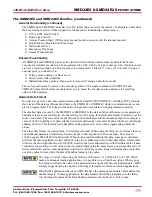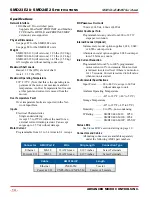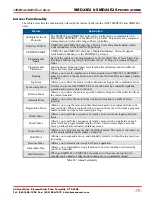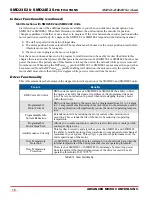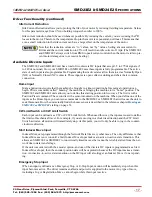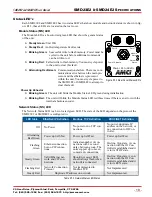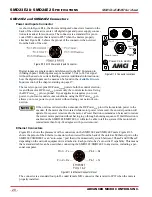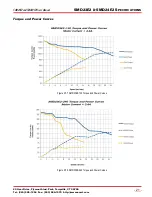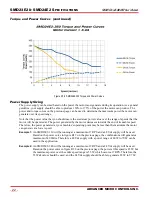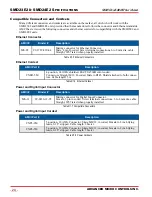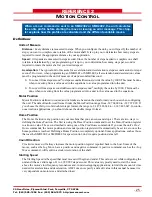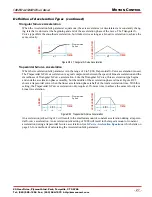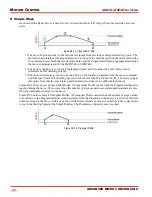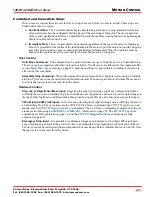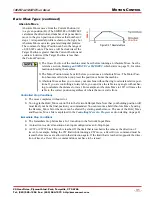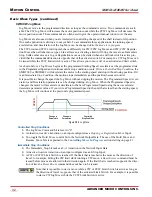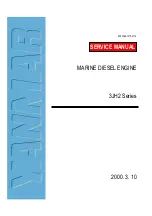
20 Gear Drive, Plymouth Ind. Park, Terryville, CT 06786
Tel: (860) 585-1254 Fax: (860) 584-1973 http://www.amci.com
SMD23E2 and SMD24E2 User’s Manual
SMD23E2 & SMD24E2 S
PECIFICATIONS
17
Driver Functionality (continued)
Idle Current Reduction
Idle Current Reduction allows you to prolong the life of your motor by reducing its idling temperature. Values
for this parameter range from 0% (no holding torque when idle) to 100%.
Idle current reduction should be used whenever possible. By reducing the current, you are reducing the I
2
R
losses in the motor. Therefore, the temperature drop in the motor is exponential, not linear. This means that
even a small reduction in the idle current can have a large effect on the temperature of the motor.
Note that the reduction values are “to” values, not “by” values. Setting a motor current to
4Arms and the current reduction to 25% will result in an idle current of 1Apk. (The SMD23E2
and SMD24E2 always switch from RMS to peak current control when the motor is idle to pre-
vent motor damage due to excessive heating.)
Available Discrete Inputs
The SMD23E2 and SMD24E2 unit has a total of two discrete DC inputs that accept 3.5 to 27Vdc signals. (5
to 24Vdc nominal) How your SMD23E2 or SMD24E2 uses these inputs is fully programmable. The active
state of each input is also programmable. Programming their active states allow them to act as Normally Open
(NO) or Normally Closed (NC) contacts. These inputs are open collector sinking and share their common
connection.
Home Input
Many applications require that the machine be brought to a known position before normal operation can
begin. This is commonly called “homing” the machine or bringing the machine to its “home” position. The
SMD23E2 and SMD24E2 units allows you to define this starting position in two ways. The first is with a
Position Preset command. The second is with a sensor mounted on the machine. When you define one of the
inputs as the Home Input, you can issue commands to the SMD23E2 or SMD24E2 that will cause the unit to
seek this sensor. How the unit actually finds the home sensor is described in the reference chapter
CW Limit Switch or CCW Limit Switch
Each input can be defined as a CW or CCW Limit Switch. When used this way, the inputs are used to define
the limits of mechanical travel. For example, if you are moving in a clockwise direction and the CW Limit
Switch activates, all motion will immediately stop. At this point, you will only be able to jog in the counter-
clockwise direction.
Start Indexer Move Input
Indexer Moves are programmed through the Network Data like every other move. The only difference is that
Indexer Moves are not run until a Start Indexer Move Input makes a inactive-to-active state transition. This
allows an SMD23E2 or SMD24E2 to run critically timed moves that cannot be reliably started from the net-
work due to data transfer lags.
If the unit was ordered with the encoder option, and one of the discrete DC inputs is programmed as a Start
Indexer Move Input, then the encoder position data will be captured whenever the DC input makes a transi-
tion. An inactive-to-active state transition on the DC input will also trigger an Indexer Move if one is pend-
ing.
Emergency Stop Input
When an input is defined as an Emergency Stop, or E-Stop Input, motion will immediately stop when this
input becomes active. The driver remains enabled and power is supplied to the motor. Any type of move,
including a Jog or Registration Move, cannot begin while this input is active.




